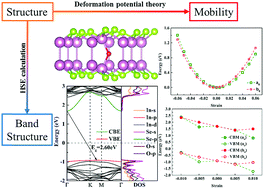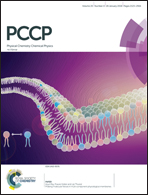Oxygen-induced degradation of the electronic properties of thin-layer InSe†
Abstract
Thin-layer indium selenide (InSe) compounds, as two-dimensional (2D) semiconductors, have been widely and intensively studied due to their high electron mobility and environmental stability. Here, we report a study demonstrating the oxygen-induced degradation of monolayer and bilayer InSe nanosheets using first-principles calculations and deformation potential theory. It is evident that O atoms prefer to substitute Se atoms instead of undergoing adsorption onto surfaces, while interstitial sites are the most stable adsorption sites of O atoms in the interior for both monolayer and bilayer InSe. Using the Heyd–Scuseria–Ernzerhof (HSE) hybrid functional, we calculated band structures and carrier mobility. The band gaps of a monolayer or bilayer InSe nanosheet with O atoms remained unchanged and corresponded to the pristine structure except for a slight decrease in the substituted cases. Additionally, no impurity levels are observed, indicating that the addition of O atoms has little effect on carrier concentrations. With the calculated mobility of monolayer InSe with and without O atoms, we show that the degradation is governed by the interstitial impurity of O atoms, whose electron mobility can decrease by 3–4 orders of magnitude. As for bilayer InSe, there is a one order of magnitude decrease at most, which indicates a stronger resistance to oxidation than that of the monolayer structure. Our calculations provide a detailed understanding of the degradation induced by O atoms from the aspects of structures and electronic properties, which is a foundation for the application and modification of thin-layer InSe.



 Please wait while we load your content...
Please wait while we load your content...